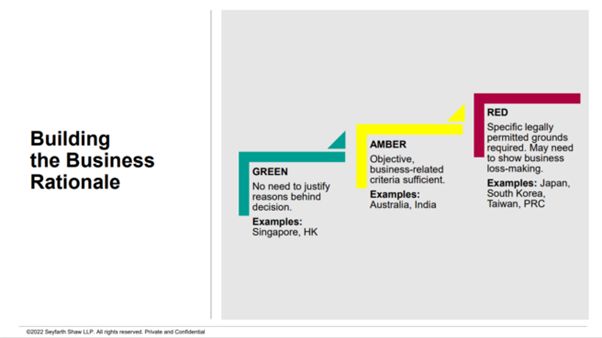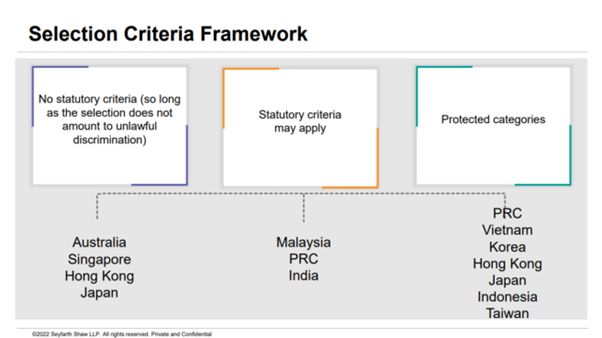In Part 1 of our series on reductions in force (RIFs) in the Asia Pacific, we addressed the importance of planning and strategy timing. In Part 2, we consider the next three things that we recommend multinational employers look out for: (#2) restructuring rationale; (#3) employee selection and redeployment, and (#4) employee/employee representative consultation.
#2 – Rationale for Restructure
While companies should make sure there is a proper business case and rationale for a RIF, it is also important to ensure that the business case falls within the permitted grounds in each specific APAC jurisdiction. The permitted grounds differ depending on jurisdiction and range from not needing to justify the reasons for a RIF to aligning with specific permitted grounds under labor laws.
Figure 1 looks at some different jurisdictions as examples.

Figure 1: The need for business rationale varies by country
At one end of the spectrum are Singapore and Hong Kong, where there are no legal requirements to justify to employees the reasons behind the decision; it is sufficient so long as companies have genuine business rationale for the RIF. At the other end are countries like Japan, South Korea, Taiwan, and the PRC, where specific grounds/criteria are required by law, and companies may be required to provide proof.
#3 – Selection and Redeployment
Selection
In terms of determining which employees are selected for redundancy, key considerations to ensure employers get it right in each relevant APAC jurisdiction include:
- Protected characteristics.In a number of jurisdictions, there are legislative prohibitions against terminating employees during a RIF process where the employee has a particular protected characteristic. The key characteristics include pregnancy, maternity leave, absence due to work-related illness or injury, or being an employee representative.
- Statutory criteria.Employers should check whether there are statutory criteria that need to be applied when selecting employees for redundancy in the affected jurisdiction, such as in Malaysia and the PRC.
- Restrictions in other instruments.Even if no mandatory statutory criteria exist, there may be other instruments, such as policies or collective agreements, that contain restrictions on who can be selected and what process is to be applied. For example, in Australia, collective agreements may specify particular considerations that must be taken into account, such as 'Last In First Out' or seeking volunteers before compulsorily retrenching employees.
- Role of objective criteria.Even where criteria are not mandated, such as in Australia, Singapore, Hong Kong, and Japan, you may still need to defend selection decisions down the track. As such, in these jurisdictions we still recommend that objective and non-discriminatory criteria are applied (e.g., skills, qualifications, licenses, experience etc.), particularly when downsizing within a group of interchangeable roles. This will help in defending against claims that the selection was for a discriminatory reason or was otherwise unfair or unjustified.

Figure 2: Framework for selection
Figure 2 is a ready reckoner summarising the key jurisdictions where there are no statutory criteria and those where statutory criteria may apply. On the right hand side are the jurisdictions where you particularly need to consider whether you are required to ring-fence employees who fall into protected categories. In jurisdictions such as Australia and Singapore, so long as the reason for selecting an employee for redundancy is not because of (or does not include) the protected attribute then there is no absolute protection merely by holding the protected attribute.
Redeployment
The next issue to consider is whether, in the relevant APAC jurisdictions, there is an obligation to consider redeployment to vacant positions within the company or the group (locally or worldwide) to try to avoid dismissal before proceeding with RIF terminations.
In Australia, for employees who earn less that the statutory unfair dismissal salary threshold, redeployment should be considered prior to termination; otherwise, the termination may not be regarded as a genuine redundancy. In Japan, redeployment is not a specific legal obligation. Nonetheless, employers are expected generally, and by the Court, to only proceed with the RIF if (among other things) it was necessary, and after every reasonable effort was made to avoid it. This would generally include considering the option of redeploying the employees. In Malaysia and the PRC, employees made redundant should as far as possible be given priority for re-engagement if the employer subsequently hires employees.
#4 – Consultation
Whether or not consultation with employees and/or trade unions/employee representatives is required varies between jurisdictions and needs to be factored into employers' timing and process. Consultation considerations include:
- Who must be notified – affected employees and/or unions? For example, in the PRC, Vietnam, and South Korea, employee representative or union consultation is mandatory.
- Timing for the process – is there a timeframe you need to be aware of?For example, in South Korea, 50 days' prior notice of a RIF must be given; in the PRC, the consultation process needs to be kicked off 30 days before any dismissal.
- What information needs to be given to employees and/or unions?For example, in Australia, certain "relevant information" may need to be provided to affected employees and their union representatives (if any) about the reasons for the RIF and selection criteria. Be aware that litigation may arise, so care should be taken when creating internal documents that may need to be discovered.
- What obligations must be met before you can proceed with the RIF?For example, in Vietnam and Japan, certain documents need to be in place before proceeding with the RIF.
All of these things need to be built into your process and timing.
Next up is Part 3 of our series, in which we'll examine numbers 5-7 in our top ten list: Severance Costs/Benefits, Timing Challenges, and Logistics and Practical Implementation.
The content of this article is intended to provide a general guide to the subject matter. Specialist advice should be sought about your specific circumstances.




